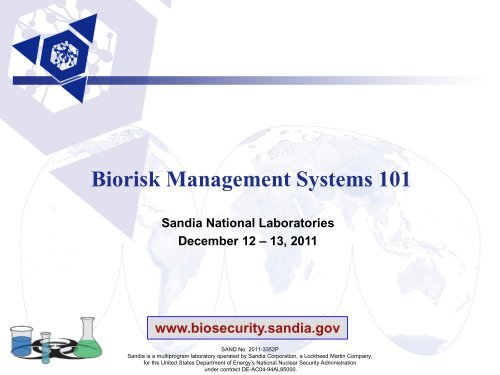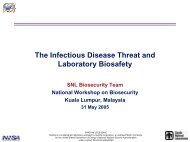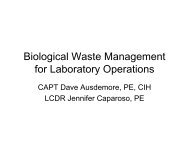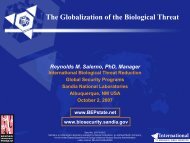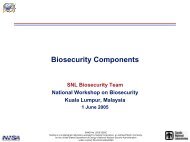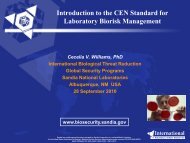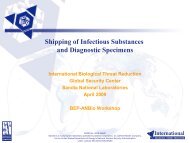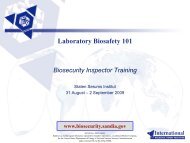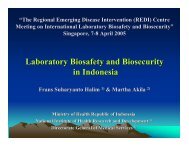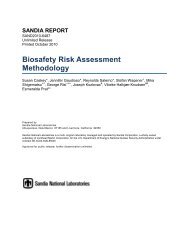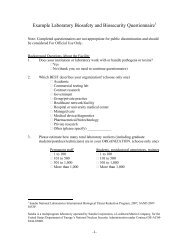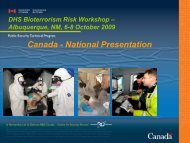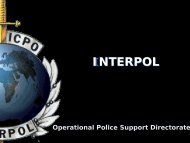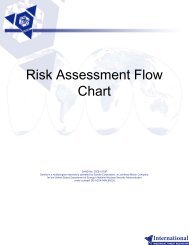Biorisk Management Systems 101 - Sandia National Laboratories
Biorisk Management Systems 101 - Sandia National Laboratories
Biorisk Management Systems 101 - Sandia National Laboratories
Create successful ePaper yourself
Turn your PDF publications into a flip-book with our unique Google optimized e-Paper software.
) ¿Cuál es el error de representación?c) Suponga que un cohete espacial, viajando a 11.000 km/h, posee un programa denavegación que tiene un reloj interno que va integrando el tiempo en períodos de 0.1segundo. ¿Por qué distancia erraría su estimación de posición después de 100 horas devuelo?12. Diseñar un algoritmo para cambiar un número X a cualquier base (menor o igual a 16). Para basessuperiores a 10 utilice los dígitos A, B, C, D, E y F para representar a los coeficientes 10, 11, 12, 13,14 y 15 respectivamente.Links:http://en.wikipedia.org/wiki/Computer_numbering_formathttp://en.wikipedia.org/wiki/IEEE_754-1985http://en.wikipedia.org/wiki/Kahan_summation_algorithm
How will we get there?• We will visualize the impact of a managementsystem• We will derive the concepts of managementsystems• We will review and use the CWA 15793:2008<strong>Biorisk</strong> <strong>Management</strong> System• See how the elements apply inside of a lab• Review a lab for compliance• Define any next steps for the lab
• Quick Review
International Laboratory <strong>Biorisk</strong><strong>Management</strong> Documents• Technical: World Health Organization• Laboratory Biosafety Manual (2004)• <strong>Biorisk</strong> <strong>Management</strong>: Laboratory BiosecurityGuidance (2006)• <strong>Management</strong>: CEN Workshop Agreements• CWA 15793 Laboratory <strong>Biorisk</strong> <strong>Management</strong>Standard• CEN WS 55 – CWA 15793 GuidanceDocument (under development)• CEN WS 53 – Biosafety ProfessionalCompetence
What is CEN?• CEN = Comité Européen de Normalisation• 30 national members• Produce technical specifications, technicalreports, and European Standards (EN)• CEN Workshop Agreements (CWA):• Produced by any interested parties• Consensus documents• Valid for 3 years• Withdraw, renew, amend, or convert(CEN Technical Specification,European standard, or ISO standard)
CWA 15793: Laboratory <strong>Biorisk</strong> <strong>Management</strong>• Developed by 76 participants from 24 countries• Is a management system standard consistentwith other international standards• The Standard is performance oriented• Does not replace national regulations• Designed to be a blueprint for biosafety &biosecurity (biorisk) program
CWA 15793:2008• <strong>Management</strong> System Standard• Not intended to replace any national or subnationalregulatory requirements• Compliance with regulatory requirementsis mandatory
How can CWA 15793:2008 be utilized?As a basis for:• Good biosafety and biosecurity practices andguidance• Regulatory support and basis for new or revisedlegislation• Framework for biorisk management systems• Audits and inspections• Certification and accreditation activities• Support for funding• International collaboration and recognition• Training
Examples of Topics Covered in CWA 15793<strong>Biorisk</strong><strong>Management</strong> PolicyPlanning for hazardidentification,risk assessmentand risk controlRoles,responsibilities andauthoritiesPersonnel training,awareness andcompetenceOperational ControlWaste <strong>Management</strong>Emergencyresponse andcontingency plansChecking andcorrective actionPerformancemeasurementRecords, documentand data controlInspection andaudit
CWA 15793:2008• Risk Assessment• Physical Description of Laboratory Environment:• Describe Procedure:• Identify Biological Hazards:• BioRAM results:• Discuss the results• Determine Acceptability of Risks:• Action control plan (mitigation measures):• Plans for review and validation:
Examples of Topics Covered in CWA 15793<strong>Biorisk</strong><strong>Management</strong> PolicyPlanning for hazardidentification,risk assessmentand risk controlRoles,responsibilities andauthoritiesPersonnel training,awareness andcompetenceOperational ControlWaste <strong>Management</strong>Emergencyresponse andcontingency plansChecking andcorrective actionPerformancemeasurementRecords, documentand data controlInspection andaudit
Example: Waste <strong>Management</strong>Reminders:• Not a technical document• Performance oriented• Describes what needs to be achieved• Allows organizations to determine howbest to achieve those objectives
Key Differences<strong>Management</strong> vs Technical Manuals???www.biorisk.eu
Summary: Why Implement CWA 15793?• Enables organizations to:• Establish and maintain a bioriskmanagement system to control orminimize risk to acceptable levels• Provide assurance that therequirements are in place andimplemented effectively• Provide a framework that can beused as basis for training andawareness raising• Seek and achieve certification orverification by an independent thirdparty
Typical Accredited Certificationof <strong>Management</strong> <strong>Systems</strong>ISO• Makes the rulesInternationalAccreditation Forum*• Harmonized world-wide interpretation ofthe rulesAccreditation Body• Quality control of the checkerCertification Body• Checks the implementation of the rulesOrganization• Implements the rules* IAF includes American Association for Laboratory Accreditation
• Document available on CEN websiteftp://ftp.cenorm.be/PUBLIC/CWAs/workshop31/CWA15793.pdf• Development of a “Guidance Document”• Kick-off meeting in Brussels, Feb 2010• Seoul Korea, June 2010• Atlanta GA USA, Dec 2010• Training and education seminars andworkshops
• Special thanks to Stefan Wagener
Now lets talk about how to implementing the CWA 15793
How did we do?


